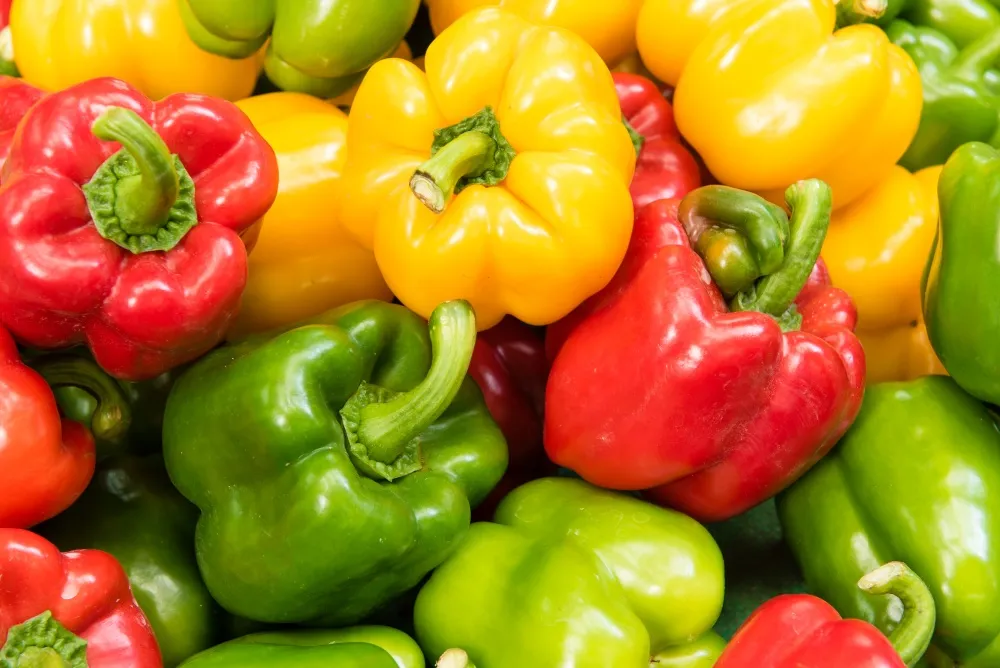Introduction
As a loving dog owner, you may often wonder whether the foods you enjoy can be safely shared with your furry friend. Bell peppers, known for their vibrant colors and rich nutrient profile, are a popular vegetable in human diets. But can dogs eat bell peppers safely? Dogs can safely eat bell peppers as long as proper precautions are taken.
Bell peppers offer low-calorie treats, are antioxidant-rich, and contain fiber, vitamins, and phytochemicals that can support your dog’s digestive health, immune system, and overall well-being. However, improper feeding, such as giving the stems or seeds, or spicy varieties, can cause digestive upset or other health issues.
This comprehensive guide covers everything you need to know about feeding bell peppers to dogs, including their nutritional benefits, potential risks, safe preparation methods, and feeding tips.

Are Bell Peppers Safe for Dogs?
Bell peppers can be safe for dogs if they are properly prepared and given in moderation. They are non-toxic and can be included as part of a balanced, species-appropriate diet. However, not all peppers are suitable for dogs.
Learn more about: Can dogs eat plums
Safe Varieties
Dogs can safely eat small amounts of green, red, yellow, or orange bell peppers. Sweet peppers only, avoid spicy or chili peppers, as capsaicin can irritate your dog’s digestive system.
Unsafe Parts
- Stems, seeds, and leaves: May cause digestive upset or pose a choking hazard.
- Spicy peppers: Can lead to vomiting, diarrhea, and irritation.
Nutritional Benefits of Bell Peppers for Dogs
Bell peppers are nutrient-rich and provide several health benefits for dogs:
Rich in Vitamins
- Vitamin A: Supports eye health, vision, and immune function.
- Vitamin C: Enhances the immune system and promotes healthy skin.
- Vitamin K: Aids in blood clotting and contributes to strong, healthy bones.
Antioxidant Content
Bell peppers contain antioxidants that help combat inflammation and protect cells from oxidative stress. Important antioxidants such as beta-carotene, lutein, and zeaxanthin support healthy eyes and skin.
Fiber for Digestive Health
Dietary fiber in bell peppers supports healthy digestion, regular bowel movements, and helps prevent constipation. Fiber also promotes a feeling of fullness, which can aid in weight management for overweight dogs.
Hydration
Bell peppers have a high water content, which can help keep dogs hydrated, especially in hot weather.
Low-Calorie Snack
Bell peppers are naturally low in calories, making them an excellent treat for dogs prone to weight gain.
How Bell Peppers Benefit Your Dog’s Health
Offering bell peppers in moderation can support several areas of your dog’s overall health:
Supports the Immune System
The combination of vitamin C and antioxidants helps strengthen the immune system, reducing the risk of infections.
Promotes Digestive Health
Fiber helps maintain regular bowel movements and supports a healthy gut microbiome.
Maintains Skin and Coat Health
Vitamins C and A, along with antioxidants, help maintain skin elasticity and a glossy coat.
Supports Eye Health
Beta-carotene in bell peppers converts to vitamin A, essential for maintaining healthy vision and preventing eye disorders.
Aids in Weight Management
With their low-calorie and high-fiber content, bell peppers are an ideal treat for dogs at risk of obesity.
Risks of Feeding Bell Peppers to Dogs
While bell peppers are generally safe, some risks must be considered:
Choking Hazard
Large pieces or stems and seeds can cause choking, especially in small dogs.
Digestive Upset
Some dogs may experience gas, diarrhea, or vomiting when first introduced to bell peppers. Dogs with sensitive digestive systems may have trouble processing the fiber-rich content of bell peppers.
Spicy Peppers
Avoid hot chili peppers, as capsaicin can cause digestive irritation, abdominal pain, or vomiting.
Allergic Reactions
Although rare, some dogs may develop itching, skin rashes, or gastrointestinal discomfort after consuming bell peppers.
Safe Feeding Practices
To ensure your dog enjoys bell peppers safely, follow these feeding tips:
Preparation
- Wash bell peppers thoroughly to remove pesticides.
- Remove stems, seeds, and leaves before feeding.
- Cut into small, bite-sized pieces to prevent choking.
Serving Size
- Feed small amounts as an occasional treat.
- Modify serving sizes according to your dog’s size and nutritional requirements.
Introduction
- Introduce bell peppers gradually to monitor for digestive issues or allergic reactions.
- Observe your dog for signs of vomiting, diarrhea, or bloating.
Cooking Bell Peppers
- Bell peppers can be served to dogs raw, lightly steamed, or gently cooked.
- Avoid using oil, salt, or seasonings, as they can be harmful to dogs.
Dogs That May Need Extra Caution
Certain dogs require additional care when feeding bell peppers:
- Puppies: Their developing digestive systems are more sensitive.
- Senior Dogs: Older dogs may have weaker digestion or health conditions.
- Dogs with Health Conditions: Dogs with diabetes, pancreatitis, or gastrointestinal issues should consult a veterinarian before consuming bell peppers.
How to Serve Bell Peppers to Dogs
- Raw Slices: Wash, remove seeds, cut into small pieces.
- Steamed Peppers: Lightly steam to soften, making them easier to digest.
- Mixed with Dog Food: Add small portions to wet or dry food for added nutrients.
- Important: Never feed spicy peppers or pickled bell peppers to dogs.
Signs Your Dog May Not Tolerate Bell Peppers
Watch for the following after introducing bell peppers:
- Vomiting or diarrhea
- Excessive gas or bloating
- Lethargy or weakness
- Itching or skin rash
If any of these symptoms appear, stop feeding bell peppers immediately and consult your veterinarian.
Health Benefits Recap
- Antioxidants: Reduce inflammation and promote cell health
- Fiber: Supports digestive health and weight management
- Vitamins A & C: Boost immunity, skin, and eye health
- Low-Calorie: Safe treat option for weight-conscious dogs.
FAQs
Yes, but small portions only, and avoid spicy varieties or seeds.
Red peppers contain more vitamin C and antioxidants, making them slightly more nutritious.
They are low in calories and high in fiber, making them a healthy treat for weight management.
Yes, in very small, soft pieces, but always monitor for digestive upset.
Yes, hot chili peppers or jalapeños contain capsaicin, which can irritate the stomach.
Conclusion
When prepared correctly, bell peppers can be a safe, nutritious, and low-calorie treat for dogs. They provide fiber, vitamins, antioxidants, and hydration, supporting digestive health, immune function, skin and coat condition, and eye health.
However, proper preparation and moderation are crucial. Always remove seeds, stems, and leaves, avoid spicy peppers, and start with small portions. Dogs with health issues or sensitive stomachs should always get a veterinary consultation before adding bell peppers to their diet

